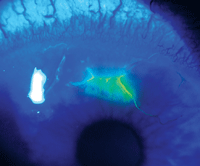 Q: What treatment options would you recommend for patients with severe pain from corneal injury (abrasion, lacerations, etc.) who need something stronger than Tylenol or an NSAID?
Q: What treatment options would you recommend for patients with severe pain from corneal injury (abrasion, lacerations, etc.) who need something stronger than Tylenol or an NSAID?
A: First, before prescribing any medication, get the patient comfortable so you can adequately examine the injured area. “The ability to physically examine the tissue really gives you an advantage in the decision-making as far as gauging the level of damage and the intensity of the pain,” says J. James Thimons, O.D., center director for Ophthalmic Consultants of Connecticut.
Second, take a thorough patient history to identify drug sensitivities, contraindications or potential drug interactions.
Be judicious about which pain management option you choose. Rarely, if ever, should you prescribe a narcotic for more than two to three days. If the pain persists, send the patient to the primary care provider or a pain management specialist. “You can ease the patient’s fear by assuring them they will not go blind, and explain that the goal of pain management is not zero pain, but reduction in pain to a manageable level,” says A. Mika Moy, O.D., of Tang Eye Center in Berkeley, Calif.
Also, consider the demands of the patient’s lifestyle and career. For patients who need to operate a motor vehicle or machinery, or have to perform high-end cognitive tasks, Dr. Thimons often uses 50mg p.o. q.i.d. tramadol because it doesn’t interfere with executive function but provides a level of control similar to hydrocodone.
However, if the patient can stay at home and relax for 24 to 48 hours, then Dr. Thimons might consider a drug like Vicodin (hydrocodone/acetaminophen, Abbott Laboratories). Percocet (oxycodone/acetaminophen, Endo Pharmaceuticals) is another alternative; however, it has a stronger, more sedating effect than hydrocodone, he says.

A corneal laceration resulting from a dog scratch. Photo: Christina Wilmer, O.D.
“Hydrocodone helps to allay anxiety—which is probably its largest benefit to the patient, as emotion is a huge component to the sensation of pain,” Dr. Moy notes. In very severe cases, Dr. Thimons sends the patient home with a sterile bottle of homatropine with enough drops for two or three days.
Talk with patients about side effects and contraindications with these drugs, and follow up within a day or two. Because the eye heals so quickly, the situation almost always improves enough in two days that you can either taper or discontinue the oral agent.
At the Tang Eye Center, Dr. Moy and chief Christina Wilmer, O.D., have found that a combination approach works well in severe cases they’ve seen, including a few where essentially the entire corneal epithelium was abraded and missing. They used a bandage contact lens in combination with a topical NSAID and an oral agent like Vicodin.
While optometrists in California don’t have access to Schedule II drugs, Dr. Wilmer finds Schedule III meds can manage the pain for most corneal issues she encounters. “We really can offer a lot of good pain management without going to a scheduled medication,” she says.
Of course, you always need to be on the lookout for malingering and drug shopping. “There are certain buzzwords or phrases that patients use that will put you on alert [for abuse],” Dr. Thimons says. It’s a red flag when the patient requests a specific type of medication, or claims that he or she needs a higher dosage or something stronger. “When you start seeing a person with a repetitive need for narcotics, you need to start looking into a bigger problem,” he says.

